Contact information
Please use the below contact details for eXpurgate support only.
Phone
+49 30 52 00 56 130
Support hours
Monday through Friday, 9 AM – 7 PM CET
Please use the below contact details for eXpurgate support only.
+49 30 52 00 56 130
Monday through Friday, 9 AM – 7 PM CET
Please verify your technical data again and please check the stated primary MX host in particular. Please correct incorrect entries.
Subsequently, please follow the instructions in the documentation of the name server configuration. Due to the high number of possible configurations we have limited the documentation to the general description of necessary modifications.
Over the test period, emails identified as spam will be specially marked. This method enables you to define filters in your email client (e.g. Microsoft Outlook, Mozilla Thunderbird, etc.), which will move the emails identified as spam e.g. to a special folder.
We provide some examples of the filter setup in popular e-mail clients. With it, you have the option of sorting the e-mails checked by eXpurgate in your email client.
By using the eXpurgate options you may determine the handling of emails in each category indiviually. For example you will be able to have all mails categorized as"spam" sent to a special email address.
To access these options please log into my.Eleven.de by using your username and password. You will find detailed guides to the filter options in our support section.
The eXpurgate spam filter and e-mail categorisation service reliably categorises all incoming e-mail and currently sorts it into 16 different categories.
Categorisation is normally carried out by adding an entry to the e-mail’s header. Based on these entries, the e-mails categorised by eXpurgate can then be sorted appropriately by any conventional e-mail program by setting up filters.
Customers can individually define how e-mails in each category are to be handled. For example the customer can specify that spam is to be forwarded to a separate central e-mail address (see Instructions for configuring the eXpurgate service).
The categorisation of e-mails by eXpurgate is archived by adding additional information to the header of an e-mail. According to this information e-mails may be sorted in an appropriate manner by using rules defined in any usual mail client.
You can specify a separate e-mail address for each individual category (Spam, bulk, clean, etc.).
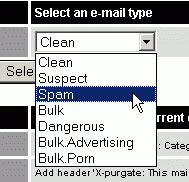


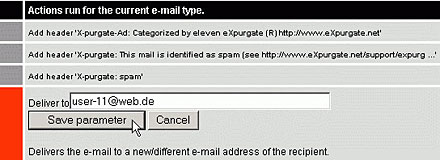
If you want to change your delivery address for other categories, or wish to make other settings, please return to point 1.
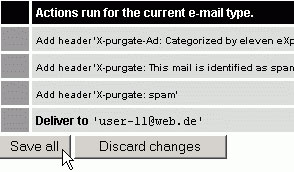

A verification e-mail is then sent to the new e-mail address - as was also the case following your initial registration. This is intended to certify that you are actually the owner of the new address.



If you want, you can use the variables suggested by eXpurgate. Please remember that the new header must be complete.
Then click the "Add action" button.
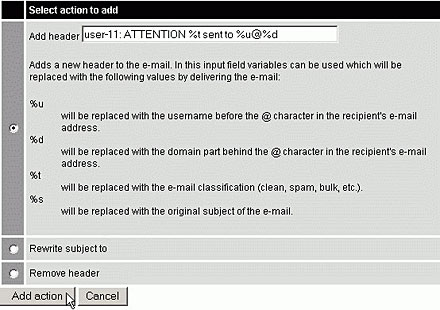
With this example, the email header reads as follows:
For corporate users:
user-11: ATTENTION Spam sent to user-11@mydomain.com
For private users:
user-11: ATTENTION Spam sent to user-11@spamfence.net
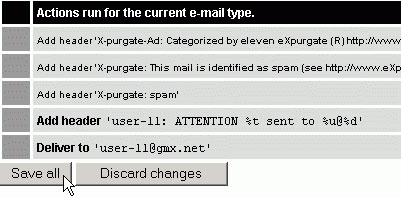
Now you can introduce additional settings as you see fit.
IMPORTANT: The "Discard changes" button cancels all modifications made to the email type in question.



Then click the "Save all" button.

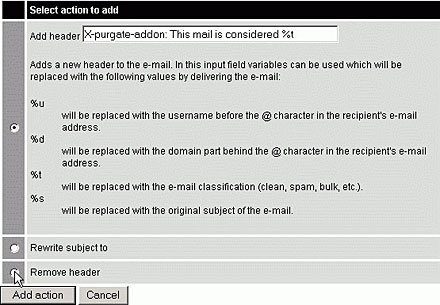
Then click the "Add action" button.
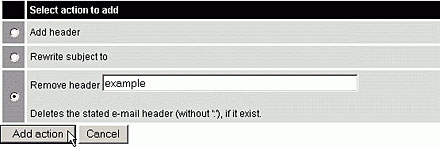
In this example, all headers beginning with "example:" will be removed for the "Spam" email type.
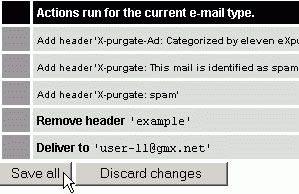
Now you can introduce additional settings as you see fit.
IMPORTANT: The "Discard changes" button cancels all modifications made to the e-mail type in question.



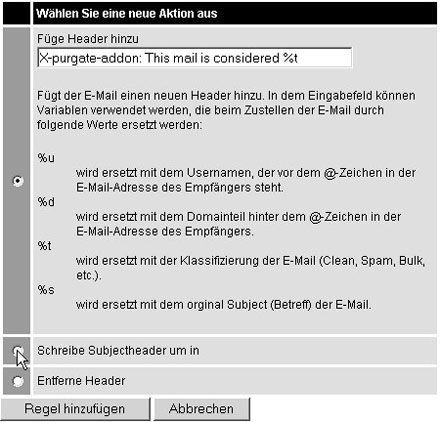
Then click the "Add action" button.
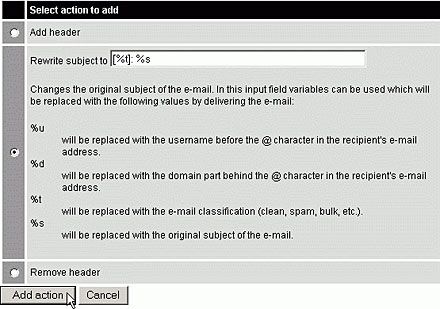
In this example, the category is to be inserted as a prefix to all subject headers for the "Spam" e-mail type:
[Spam]: Original subject
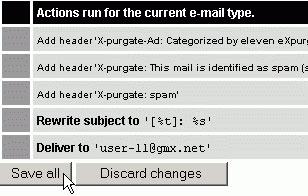
Now you can introduce additional settings as you see fit.
IMPORTANT: The "Discard Changes" button cancels all modifications made to the e-mail type in question.
With this function, clients can specify that one email type is to be handled in exactly the same way as another. Please note that this also involves copying the entire eXpurgate header information from one category to another, thereby overwriting the old eXpurgate header. However, prior to implementing this action, you have the option of introducing additional rules for the email types in question. For example, you have the opportunity to add your own headers which, despite the equal treatment function, will still be displayed in the future. This allows users to continue to differentiate between email types.
This function and the "Deliver to" rule are mutually exclusive. To change this, you need to delete the exclusionary rule first.
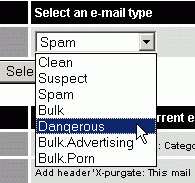


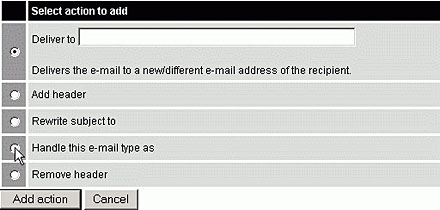
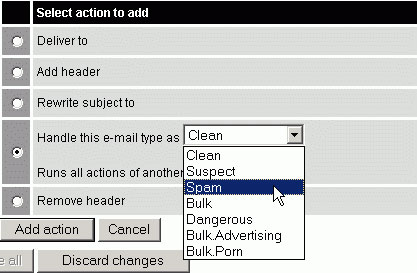
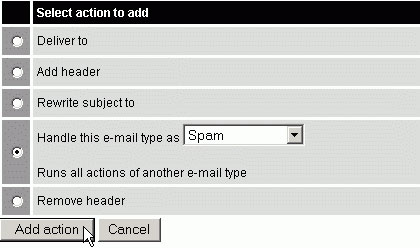
In this example, the "dangerous" e-mail type is to be treated in the same way as Spam in the future.

Now you can introduce additional settings as you see fit.
eXpurgate's default setting treats the "bulk.advertising" and "bulk.porn" categories in the same way as Spam. You need to delete this rule prior to changing this setting.
IMPORTANT: The "Discard Changes" button cancels all modifications made to the e-mail type in question.
You will find an additional "X-purgate"-header pasted in each e-mail during the check procedure. Depending on the result of the check the header will carry amongst other things the following information:
identified as Spam:
X-purgate: This mail is identified as Spam
X-purgate: spam
Emails sent in a way typical for newsletters, lists, chain letters and sometimes even for joke-mails or so-called "opt-in infomercials" (i.e. sent to many recipients):
X-purgate: This mail is sent in bulk
X-purgate: bulk
E-mails having partly suspect content typical for Spams, but which do not meet the 'sent in bulk'-criterion:
X-purgate: This mail is considered suspect
X-purgate: suspect
Important: The 'suspect' category is not equal to 'Spam' !
Private e-mails may also contain some 'suspect' content, so we suggest not to automatically delete e-mails marked like that !
"clear" e-mails will carry an additional header with the following information:
X-purgate: This mail is considered clean
X-purgate: clean
NEW: Additionally, bounce e-mails are tagged with the header:
X-purgate-type: clean.bounce
Furthermore Eleven will mark potentially malicious e-mails, which contain e.g. executable codes - codes which could start actions without the approval of the user by just displaying the e-mail in the preview window - with the following additional header information:
X-purgate: This mail contains potentially dangerous content
X-purgate: dangerous
Some types of potentially dangerous e-mails are marked with the following subcategories:
X-purgate: This mail contains potentially dangerous content
X-purgate: dangerous
X-purgate-type: dangerous.code
X-purgate: This mail uses potentially dangerous features
(IFRAME-Tag)
X-purgate: dangerous
X-purgate-type: dangerous.iframe
X-purgate: This mail contains potentially dangerous
attachment
X-purgate: dangerous
X-purgate-type: dangerous.attachment
The last mentioned category will be used to mark e-mails, which have an executable file attached. Please note, that we do not check attachments for viruses.
To check e-mails against viruses, you can optionally activate the "Virus Check". E-mails containing viruses are marked as:
X-purgate: This mail contains a virus
X-purgate: dangerous
X-purgate-type: dangerous.virus
There are two more categories: 'bulk.advertising' and 'bulk.porn'. The first one characterizes commercial e-mails which are - contrary to their appearances - no Spam, but which are usually not wanted.
'bulk.porn' characterizes all circular e-mails with pornographic content, which are no typical Spam as well (e.g. pornographic newsletter).
Both categories are subcategories of 'bulk'. But in the default setting we handle those e-mails as Spam. As a matter of course you can change the settings.
In the default setting the header information looks like this:
X-purgate: This mail is identified as Spam
X-purgate: Spam
X-purgate-type: bulk.advertising
respectively:
X-purgate: This mail is identified as Spam
X-purgate: Spam
X-purgate-type: bulk.porn
If you change the default settings the header information looks like this:
X-purgate: This mail is sent in bulk
X-purgate: bulk
X-purgate-type: bulk.advertising
respectively:
X-purgate: This mail is sent in bulk
X-purgate: bulk
X-purgate-type: bulk.porn
In addition to this empty or almost empty e-mails are marked with the following headers:
X-purgate: This mail is empty
X-purgate: clean
X-purgate-type: clean.empty
X-purgate: This mail is almost empty
X-purgate: clean
X-purgate-type: clean.almost-empty
X-purgate: This mail has an empty body
X-purgate: clean
X-purgate-type: clean.empty-body
clean.empty are e-mails containing no content at all, neither in the subject nor in the body. Because these e-mails are as unwanted as spam in the default setting we handle those e-mails as Spam.
In the default setting the header information for this category looks like this:
X-purgate: This mail is identified as Spam
X-purgate: Spam
X-purgate-type: clean.empty
The method mentioned above allows to define a filter for your e-mail client (eg. Microsoft Outlook, Eudora etc.) that will respond during the test stage to this additional header information and will move the identified e-mail in a special folder (e.g. SpamTest).
We provide Instructions for several e-mail clients on how to set up filtering have generated instructions, which will help you by setting up these filters.
Our configuration tool gives you the chance to add your own header for each category. By sending some e-mail types to different e-mail addresses you can relieve your mailbox completely from Spam and other undesirable e-mails.
For using the eXpurgate ASP service, your nameserver configuration needs to be modified.
[...]
IN MX 10 YourMX.YourDomain.com.
IN MX 50 YourBackupMX.YourDomain.com.
[...]
to:
[...]
IN MX 10 mxA.expurgate.net.
IN MX 10 mxB.expurgate.net.
IN MX 10 mxA.expurgate.de.
IN MX 10 mxB.expurgate.de.
[...]
[...]
mxtls.expurgate.net
[...]
With this modification an external email sent to an addressee in your domain will not be delivered directly to your mail server anymore. Before the final delivery, the email will be routed through the eXpurgate server, where it is checked.
Please do not change these until Eleven has confirmed the activation in the eXpurgate system. Otherwise emails can be lost.
Please don't forget to update the 'serial' (SOA record in the name server's zone file) and restart your name server, after making changes to the name server configuration.